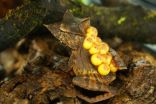(Press-News.org) For over 100 years, it was assumed that the penicillin-producing mould fungus Penicillium chrysogenum only reproduced asexually through spores. An international research team led by Prof. Dr. Ulrich Kück and Julia Böhm from the Chair of General and Molecular Botany at the Ruhr-Universität has now shown for the first time that the fungus also has a sexual cycle, i.e. two "genders". Through sexual reproduction of P. chrysogenum, the researchers generated fungal strains with new biotechnologically relevant properties - such as high penicillin production without the contaminating chrysogenin. The team from Bochum, Göttingen, Nottingham (England), Kundl (Austria) and Sandoz GmbH reports in PNAS. The article will be published in this week's Online Early Edition and was selected as a cover story.
Only penicillin producer
About 100 years ago, Alexander Fleming demonstrated the formation of penicillin in Penicillium chrysogenum. To date, there is no other known producer of the antibiotic penicillin, which has an annual global market value of about six billion Euros.
Combining genes and breeding offspring with new properties
Not only animals and plants, but also many microorganisms such as fungi and algae can reproduce sexually. The advantage: the progenies possess a combination of genes from both mating partners and thus have new properties. Sexual reproduction in fungi is, however, not the rule. Most reproduce via spores which, in the case of moulds, occur as white, green or black deposits on spoiled food. These spores only bear the genes of one parent fungus. "Five years ago we already detected the existence of so-called sex genes in Penicillium chrysogenum", says Prof. Kück. Now, the researchers have discovered specific environmental conditions in which the fungus actually reproduces sexually. The decisive thing was to breed fungal strains in the dark under oxygen deprivation conditions in a nutrient medium supplemented with the vitamin biotin. The offspring exhibited new properties, both at the molecular level, as well as in their phenotypes.
Results could be applicable to other fungi
Using so-called microarray analysis, the biologists also investigated the activity of all the approximately 12,000 genes of the mould fungus. The result: the sex genes control the activity of biologically relevant genes, for example those for penicillin production. "We presume that the findings can also be applied to other fungi", says Ulrich Kück, "such as Penicillium citrinum and Aspergillus terreus that produce cholesterol-lowering statins, or Penicillium brevicompactum and Tolypocladium inflatum, which produce immunosuppressives that are used in all organ transplantations". The researchers conducted the work in the Christian Doppler Laboratory "Biotechnology of Fungi" at the Ruhr-Universität with funding from the Christian Doppler Society (Vienna).
### Bibliographic record
J. Böhm, B. Hoff, C.M. O'Gorman, S. Wolfers, V. Klix, D. Binger, I. Zadra, H. Kürnsteiner, S. Pöggeler, P.S. Dyer, U. Kück (2013): Sexual reproduction and mating-type – mediated strain development in the penicillin-producing fungus Penicillium chrysogenum, PNAS, DOI: 10.1073/pnas.1217943110
Figure online
A figure related to this press release can be found online at http://aktuell.ruhr-uni-bochum.de/pm2013/pm00004.html.en
Further information
Prof. Dr. Ulrich Kück, Chair of General and Molecular Botany, Faculty of Biology and Biotechnology at the Ruhr-Universität, 44780 Bochum, Germany, Tel. +49/234/32-28212, E-Mail: Ulrich.Kueck@rub.de
Julia Böhm, MSc, Chair of General and Molecular Botany, Faculty of Biology and Biotechnology at the Ruhr-Universität, 44780 Bochum, Germany, Tel. +49/234/32-25656, E-Mail: Julia.Boehm@rub.de
Editor: Dr. Julia Weiler
Unlike we thought for 100 years: Molds are able to reproduce sexually
Researchers grow penicillin-producing fungi with new properties
2013-01-08
ELSE PRESS RELEASES FROM THIS DATE:
Parasitic worms may help treat diseases associated with obesity
2013-01-08
Athens, Ga. – On the list of undesirable medical conditions, a parasitic worm infection surely ranks fairly high. Although modern pharmaceuticals have made them less of a threat in some areas, these organisms are still a major cause of disease and disability throughout much of the developing world.
But parasites are not all bad, according to new research by a team of scientists now at the University of Georgia, the Harvard School of Public Health, the Université François Rabelais in Tours, France, and the Central South University, Changsha, Hunan, China.
A study ...
PNAS: Shareholder responsibility could spur shift to sustainable energy
2013-01-08
The research carried out at IIASA in collaboration with the Potsdam Institute for Climate Impact Research demonstrates that there is fundamental rigidity, known as lock-in, within the energy economy that favors the use of fossil fuels and nuclear power despite their large environmental and social costs. The researchers identify that this rigidity of the existing energy economy could be considerably reduced by introducing new rules that hold shareholders of companies liable for the damages caused by the companies they own. Allocating the liability between the company and ...
Females tagged in wasp mating game
2013-01-08
The flick of an antenna may be how a male wasp lays claim to his harem, according to new research at Simon Fraser University.
A team of biologists, led by former PhD graduate student Kelly Ablard, found that when a male targeted a female, he would approach from her from the left side, and once in range, uses the tip of his antenna to tap her antenna.
Ablard suggests the act transfers a yet unidentified specimen-specific pheromone onto the female's antenna that marks the female as "out of bounds," or "tagged."
The tagging-pheromone helps a male relocate the females ...
Rice University discovers that graphene oxide soaks up radioactive waste
2013-01-08
Graphene oxide has a remarkable ability to quickly remove radioactive material from contaminated water, researchers at Rice University and Lomonosov Moscow State University have found.
A collaborative effort by the Rice lab of chemist James Tour and the Moscow lab of chemist Stepan Kalmykov determined that microscopic, atom-thick flakes of graphene oxide bind quickly to natural and human-made radionuclides and condense them into solids. The flakes are soluble in liquids and easily produced in bulk.
The experimental results were reported in the Royal Society of Chemistry ...
Genetic matchmaking saves endangered frogs
2013-01-08
What if Noah got it wrong? What if he paired a male and a female animal thinking they were the same species, and then discovered they were not the same and could not produce offspring? As researchers from the Smithsonian's Panama Amphibian Rescue and Conservation Project race to save frogs from a devastating disease by breeding them in captivity, a genetic test averts mating mix-ups.
At the El Valle Amphibian Conservation Center, project scientists breed 11 different species of highland frogs threatened by the chytrid fungus Batrachochytrium dendrobatidis, which has already ...
New American Chemical Society video series: Conversations with Celebrated Scientists
2013-01-08
The American Chemical Society (ACS), the world's largest scientific society, today launched a new video series that will feature noted scientists discussing the status of knowledge in their fields, their own research, and its impacts and potential impacts on society. Chemistry over Coffee: Conversations with Celebrated Scientists is available at www.acs.org/ChemistryOverCoffee.
The launch episode features Chad Mirkin, Ph.D., and Paul Weiss, Ph.D., internationally known leaders in nanotechnology. Mirkin, director of Northwestern University's International Institute for ...
Teens susceptible to hepatitis B infection despite vaccination as infants
2013-01-08
New research reveals that a significant number of adolescents lose their protection from hepatitis B virus (HBV) infection, despite having received a complete vaccination series as infants. Results in the January 2013 issue of Hepatology, a journal published by Wiley on behalf of the American Association for the Study of Liver Diseases, suggest teens with high-risk mothers (those positive for HBeAg) and teens whose immune system fails to remember a previous viral exposure (immunological memory) are behind HBV reinfection.
Infection with HBV is a major global health concern ...
First study of Oregon's Hmong reveals surprising influences on cancer screenings
2013-01-08
CORVALLIS, Ore. – Cervical cancer rates for Hmong women are among the highest in the nation, yet past research has shown that cervical and breast cancer screening rates for this population are low – in part because of the Hmong's strong patriarchal culture.
However, a new study by Oregon State University researchers examining attitudes regarding breast and cervical cancer screening among Oregon's Hmong population shows a much more complicated picture. The study found that Hmong women often make their own health decisions, but in an environment in which screening is not ...
U-M sibling study discovers genetic region linked to control of key blood-clotting protein
2013-01-08
ANN ARBOR—In 2006, the lab of Dr. David Ginsburg at the Life Sciences Institute put a call out for siblings attending the University of Michigan to donate blood for a study of blood-clotting disorders.
The samples were collected over three years and have now enabled the researchers to identify the specific parts of the genome responsible for levels of a key substance for blood clotting. The findings were reported online Dec. 24 in the Proceedings of the National Academy of Sciences.
Von Willebrand disease is the most common hereditary blood-clotting disorder—it's more ...
Postpartum depression prevalent in under-developed countries, could impact baby health and mortality
2013-01-08
ANN ARBOR, Mich. — Postpartum depression not only affects mothers but it could mean higher health risks for the baby – especially in low-income countries like Ghana where the condition isn't well-recognized, University of Michigan Health System research shows.
Efforts to reduce child mortality and improve infant growth, health, and nutritional status in less-developed countries must address the mental health of new moms, the study suggests.
Two-thirds of participating mothers of sick, hospitalized babies in Ghana showed high risk for symptoms of clinical depression ...
LAST 30 PRESS RELEASES:
This new understanding of T cell receptors may improve cancer immunotherapies
A new fossil face sheds light on early migrations of ancient human ancestor
A new immunotherapy approach could work for many types of cancer
A new way to diagnose deadly lung infections and save lives
40 percent of MRI signals do not correspond to actual brain activity
How brain-inspired algorithms could drive down AI energy costs
Gum disease may be linked to plaque buildup in arteries, higher risk of major CVD events
Contrails are a major driver of aviation’s climate impact
Structure of dopamine-releasing neurons relates to the type of circuits they form for smell-processing
Reducing social isolation protects the brain in later life
Keeping the heart healthy increases longevity even after cancer
Young adults commonly mix cannabis with nicotine and tobacco
Comprehensive review illuminates tau protein's dual nature in brain health, disease, and emerging psychiatric connections
Book prepares K-12 leaders for the next public health crisis
Storms in the Southern Ocean mitigates global warming
Seals on the move: Research reveals key data for offshore development and international ecology
Sports injuries sustained during your period might be more severe
World's first successful 2 Tbit/s free-space optical communication using small optical terminals mountable on satellites and HAPS
Can intimate relationships affect your heart? New study says ‘yes’
Scalable and healable gradient textiles for multi‑scenario radiative cooling via bicomponent blow spinning
Research shows informed traders never let a good climate crisis go to waste
Intelligent XGBoost framework enhances asphalt pavement skid resistance assessment
Dual-function biomaterials for postoperative osteosarcoma: Tumor suppression and bone regeneration
New framework reveals where transport emissions concentrate in Singapore
NTP-enhanced lattice oxygen activation in Ce-Co catalysts for low-temperature soot combustion
Synergistic interface engineering in Cu-Zn-Ce catalysts for efficient CO2 hydrogenation to methanol
COVID-19 leaves a lasting mark on the human brain
Scientists use ultrasound to soften and treat cancer tumors without damaging healthy tissue
Community swimming program for Black youth boosts skills, sense of belonging, study finds
Specific depressive symptoms in midlife linked to increased dementia risk
[Press-News.org] Unlike we thought for 100 years: Molds are able to reproduce sexuallyResearchers grow penicillin-producing fungi with new properties

